


3.2. Results and notes on selected galaxies
In this subsection a brief description of the observed eDIG morphology
of selected galaxies is presented in addition to some background
information, relevant in the DIG context for those targets. The galaxies
are listed according to their increasing Right Ascension. The
H images
of all survey galaxies are shown together with the accompanying broad band
images (R-band, and unsharp-masked R-band image) in Figs. 22-54
(available only in electronic form at EDP Sciences). However, some
enlargements of selected galaxies with characteristic and spectacular
eDIG morphology are included in logarithmic scale as separate figures in
this section, in order to highlight some finer details of eDIG emission. A
comparison with observations by other researchers from various wavelength
regimes in the context of the disk-halo interaction is made, whenever such
observations were available in the literature.
images
of all survey galaxies are shown together with the accompanying broad band
images (R-band, and unsharp-masked R-band image) in Figs. 22-54
(available only in electronic form at EDP Sciences). However, some
enlargements of selected galaxies with characteristic and spectacular
eDIG morphology are included in logarithmic scale as separate figures in
this section, in order to highlight some finer details of eDIG emission. A
comparison with observations by other researchers from various wavelength
regimes in the context of the disk-halo interaction is made, whenever such
observations were available in the literature.
The H morphology of
NGC24 comprises of planar DIG which is
visible between several bright HII regions in the disk. No
extraplanar DIG is detected which is basically due to the fact that this
galaxy is not perfectly edge-on.
Guthrie (1992)
lists an inclination of 78°. Although the
LFIR/D225 ratio (for a
definition of this expression please cf. Paper I) is quite low, the
S60 / S100 ratio is moderate, and as the
H
morphology of
NGC24 comprises of planar DIG which is
visible between several bright HII regions in the disk. No
extraplanar DIG is detected which is basically due to the fact that this
galaxy is not perfectly edge-on.
Guthrie (1992)
lists an inclination of 78°. Although the
LFIR/D225 ratio (for a
definition of this expression please cf. Paper I) is quite low, the
S60 / S100 ratio is moderate, and as the
H distribution implies
there is considerable star formation activity all over the disk. Additional
evidence comes from a UV-study of nearby galaxies, where the morphology of
the nuclear region in NGC24 was studied
(Maoz et al., 1996).
They classify
NGC24 as a galaxy with star-forming morphology, and several knots or
compact sources can be identified on the UV (~ 2300Å) image,
obtained with the Faint Object Camera (FOC) on-board HST. These regions are
either compact star clusters or individual OB stars.
distribution implies
there is considerable star formation activity all over the disk. Additional
evidence comes from a UV-study of nearby galaxies, where the morphology of
the nuclear region in NGC24 was studied
(Maoz et al., 1996).
They classify
NGC24 as a galaxy with star-forming morphology, and several knots or
compact sources can be identified on the UV (~ 2300Å) image,
obtained with the Faint Object Camera (FOC) on-board HST. These regions are
either compact star clusters or individual OB stars.
UGC260 is shown with another smaller edge-on galaxy, CGCG434-012,
located 2'.4 west of UGC260 (see
Fig. 21), which has a similar
redshift
( v = 47 km
s-1).
Reshetnikov & Combes
(1996)
included them in
their list of tidally-triggered disk thickening galaxies. Indeed, the
morphology in the continuum-subtracted
H
v = 47 km
s-1).
Reshetnikov & Combes
(1996)
included them in
their list of tidally-triggered disk thickening galaxies. Indeed, the
morphology in the continuum-subtracted
H image looks quite
distorted. The HII regions are not aligned and just below
the disk in the very northern part seems to be a small additional galaxy
possibly in the process of merging, or this represents debris tidal tails.
Extraplanar DIG is detected, representing a faint layer, with a few
individual emission patches. The NED lists another galaxy pair between
UGC260 and CGCG434-012, which is barely visible in our R-band
image. We cannot rule out in this particular case, that the eDIG
emission is triggered by interaction of one of the nearby galaxies.
image looks quite
distorted. The HII regions are not aligned and just below
the disk in the very northern part seems to be a small additional galaxy
possibly in the process of merging, or this represents debris tidal tails.
Extraplanar DIG is detected, representing a faint layer, with a few
individual emission patches. The NED lists another galaxy pair between
UGC260 and CGCG434-012, which is barely visible in our R-band
image. We cannot rule out in this particular case, that the eDIG
emission is triggered by interaction of one of the nearby galaxies.
This edge-on galaxy is paired with another edge-on spiral, MCG-2-3-15.
However, these two galaxies are not physically associated, as MCG-2-3-15
has a much higher radial velocity of
vrad = 5765 km s-1.
Hence its H emission is
shifted outside the passband of the used
H
emission is
shifted outside the passband of the used
H filter. MCG-2-3-16 on
the other side is not very prominent
in H
filter. MCG-2-3-16 on
the other side is not very prominent
in H . It is one of our
12 survey galaxies, which has no detectable
FIR flux at 60µm or 100µm at the sensitivity of
IRAS. A small arc
is seen in the western portion, extending about 430 pc north of the disk,
which is not extraplanar. The disk shows a slight asymmetry in thickness
from east to west which might be a projection effect due to a slight
deviation from the edge-on character.
. It is one of our
12 survey galaxies, which has no detectable
FIR flux at 60µm or 100µm at the sensitivity of
IRAS. A small arc
is seen in the western portion, extending about 430 pc north of the disk,
which is not extraplanar. The disk shows a slight asymmetry in thickness
from east to west which might be a projection effect due to a slight
deviation from the edge-on character.
UGC1281 was included in the Effelsberg/VLA radio continuum survey by
Hummel et al. (1991).
However, no radio halo was detected. The
H image did not reveal any extraplanar DIG emission. UGC1281 has also
not been detected by IRAS, so this altogether hints for a low star
formation activity. However, the
H
image did not reveal any extraplanar DIG emission. UGC1281 has also
not been detected by IRAS, so this altogether hints for a low star
formation activity. However, the
H images show several
bright HII regions in the disk which are not aligned. Two
bright emission knots are slightly offset from the plane to the south.
images show several
bright HII regions in the disk which are not aligned. Two
bright emission knots are slightly offset from the plane to the south.
UGC2082 is a northern edge-on spiral galaxy, which is located in the
direction of the NGC1023 group
(Tully, 1980).
It has been investigated on
the basis of a HST survey of large and bright nearby galaxies, studied with
the FOC in the UV-regime at
 ~ 2300Å
(Maoz et al., 1996).
However,
UGC2082 has not been detected, which is an indication that the SF activity
within this galaxy is very low. That is reflected in our
H
~ 2300Å
(Maoz et al., 1996).
However,
UGC2082 has not been detected, which is an indication that the SF activity
within this galaxy is very low. That is reflected in our
H images as
well. We do not detect significant emission except some HII
regions in the disk. The diagnostic FIR ratios are very low, too.
images as
well. We do not detect significant emission except some HII
regions in the disk. The diagnostic FIR ratios are very low, too.
ESO362-11 has a
LFIR / D225 ratio of ~
2.6, which indicates a moderate SF activity. In our
H images a weak layer of
eDIG is found, but no filaments or plumes are detected. ESO362-11 is
listed in the catalog of Southern Peculiar Galaxies and Associations
(Arp & Madore, 1987)
as AM0514-370, possibly due to a chain of 4 galaxies which
are located in the vicinity of ESO362-11. These are on the outskirts of
our covered field, and therefore are not shown in our appendix image.
Telesco et al. (1988)
report that galaxy interactions enhance the efficiency of SF
activity, which is very likely. However, in the case of ESO362-11 it is
not clear, whether or not the chain of galaxies, which are not in the close
vicinity of ESO362-11, are able to enhance the SF activity.
Coziol et al. (1998)
even have classified ESO362-11 on the basis of their Pico Dos Dias
Survey as a starburst galaxy, based on FIR spectral indices.
images a weak layer of
eDIG is found, but no filaments or plumes are detected. ESO362-11 is
listed in the catalog of Southern Peculiar Galaxies and Associations
(Arp & Madore, 1987)
as AM0514-370, possibly due to a chain of 4 galaxies which
are located in the vicinity of ESO362-11. These are on the outskirts of
our covered field, and therefore are not shown in our appendix image.
Telesco et al. (1988)
report that galaxy interactions enhance the efficiency of SF
activity, which is very likely. However, in the case of ESO362-11 it is
not clear, whether or not the chain of galaxies, which are not in the close
vicinity of ESO362-11, are able to enhance the SF activity.
Coziol et al. (1998)
even have classified ESO362-11 on the basis of their Pico Dos Dias
Survey as a starburst galaxy, based on FIR spectral indices.
This little studied nearby, southern edge-on galaxy has both a moderate
ratio of
LFIR / D225, and
S60 / S100. Its
H morphology reveals an extended layer, not as prominent as in NGC891 or
NGC3044, but still quite intense. The distribution
of the H
morphology reveals an extended layer, not as prominent as in NGC891 or
NGC3044, but still quite intense. The distribution
of the H emission is asymmetric which could be a projection effect, if we were
looking
at the very end of the spiral arm to the south along the line of sight,
whereas the spiral arm to the north could be winded more tightly. Quite
extraordinary is an additional emission component, which shows up in the
whole field around ESO209-9. We speculate that this emission, which is
shown in its fully covered extent in the
H
emission is asymmetric which could be a projection effect, if we were
looking
at the very end of the spiral arm to the south along the line of sight,
whereas the spiral arm to the north could be winded more tightly. Quite
extraordinary is an additional emission component, which shows up in the
whole field around ESO209-9. We speculate that this emission, which is
shown in its fully covered extent in the
H +continuum image (see
Fig. 3), is of Galactic origin. Quite
remarkably, there is no hint of any
filamentary emission in the broad R-band image. Our first impression
was that this could be straylight from a bright star just outside the
covered CCD field. However, as there was neither a shift (after alignment)
nor a change in the emission pattern noticed in the two individual
H
+continuum image (see
Fig. 3), is of Galactic origin. Quite
remarkably, there is no hint of any
filamentary emission in the broad R-band image. Our first impression
was that this could be straylight from a bright star just outside the
covered CCD field. However, as there was neither a shift (after alignment)
nor a change in the emission pattern noticed in the two individual
H images, which were offset by 20" from one another, and furthermore
such
structures were never recorded prior or after these exposures in other
object frames, we suspect that these structures indeed have a Galactic
origin. A visual inspection of both the blue and red DSS images did not
reveal anything conclusive. Unfortunately, the IR DSS plate of the region
around ESO209-9 is not yet obtained/digitized. The IRAS maps show some
emission in that area, however, the resolution is not sufficient enough to
resolve these structures clearly. A possible explanation could be, that
this emission is Galactic cirrus. This would not be unreasonable, since
ESO209-9 has a galactic latitude of only
b
images, which were offset by 20" from one another, and furthermore
such
structures were never recorded prior or after these exposures in other
object frames, we suspect that these structures indeed have a Galactic
origin. A visual inspection of both the blue and red DSS images did not
reveal anything conclusive. Unfortunately, the IR DSS plate of the region
around ESO209-9 is not yet obtained/digitized. The IRAS maps show some
emission in that area, however, the resolution is not sufficient enough to
resolve these structures clearly. A possible explanation could be, that
this emission is Galactic cirrus. This would not be unreasonable, since
ESO209-9 has a galactic latitude of only
b  -11°.
Unfortunately, this position is just outside the regions studied by the
AAO/UKST H
-11°.
Unfortunately, this position is just outside the regions studied by the
AAO/UKST H survey 4 of the southern
galactic plane (e.g.,
Parker et al., 1999),
which would have been a good
test for comparison. It could also be extended red emission (ERE) in the
diffuse interstellar medium. This ERE was found for high-galactic cirrus
clouds by
Szomoru &
Guhathakurta (1998).
They found a peak of cirrus ERE at
survey 4 of the southern
galactic plane (e.g.,
Parker et al., 1999),
which would have been a good
test for comparison. It could also be extended red emission (ERE) in the
diffuse interstellar medium. This ERE was found for high-galactic cirrus
clouds by
Szomoru &
Guhathakurta (1998).
They found a peak of cirrus ERE at
 ~
6000Å. However, in order to unravel the true nature of
this filamentary emission, this should be re-investigated by independent
deep H
~
6000Å. However, in order to unravel the true nature of
this filamentary emission, this should be re-investigated by independent
deep H images using a
different instrumental setup, and supplemental
spectroscopy. Fortunately, very recently, we downloaded an available
H
images using a
different instrumental setup, and supplemental
spectroscopy. Fortunately, very recently, we downloaded an available
H image from the
Southern H
image from the
Southern H Sky Survey Atlas
(SHASSA) 5
(see Fig. 2), which
became available very recently. For details on SHASSA we refer to
Gaustad et al. (2001).
Indeed, the field around the galaxy ESO209-9 shows
detectable H
Sky Survey Atlas
(SHASSA) 5
(see Fig. 2), which
became available very recently. For details on SHASSA we refer to
Gaustad et al. (2001).
Indeed, the field around the galaxy ESO209-9 shows
detectable H emission,
and the H
emission,
and the H morphology is
clearly recovered, despite the spatial resolution of the SHASSA is much
lower than in our images.
morphology is
clearly recovered, despite the spatial resolution of the SHASSA is much
lower than in our images.
 |
Figure 2. Field No. 51 of the Southern
H |
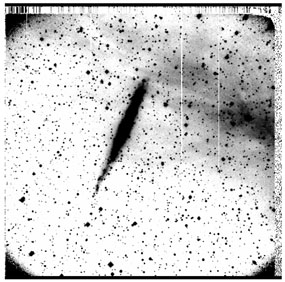 |
Figure 3. Field around ESO209-9, showing
very structured, cirrus-like galactic emission in this
H |
NGC3003 has been investigated spectroscopically by
(Ho et al., 1995) in
search of dwarf Seyfert nuclei, who concluded, based on a detected
broad emission complex centered at
 4650Å, that this
galaxy is a Wolf-Rayet galaxy. NGC3003 has a modest
LFIR / D225 ratio
(1.65), however, the
S60 / S100 ratio of ~ 0.34 hints
that there
is some SF activity due to enhanced dust temperatures. Furthermore, due to
the slight deviation from its edge-on character, no extraplanar emission
can be identified reliably. The
H
4650Å, that this
galaxy is a Wolf-Rayet galaxy. NGC3003 has a modest
LFIR / D225 ratio
(1.65), however, the
S60 / S100 ratio of ~ 0.34 hints
that there
is some SF activity due to enhanced dust temperatures. Furthermore, due to
the slight deviation from its edge-on character, no extraplanar emission
can be identified reliably. The
H distribution, however,
reveals strong planar DIG, consistent with the observations by
Hoopes et al. (1999).
Several bright emission knots can be discerned. About four decades ago a SN
has been detected 34"E, and 17"N of the nucleus (SN1961F).
distribution, however,
reveals strong planar DIG, consistent with the observations by
Hoopes et al. (1999).
Several bright emission knots can be discerned. About four decades ago a SN
has been detected 34"E, and 17"N of the nucleus (SN1961F).
This is one of the galaxies with the highest LFIR / D225 ratio in our survey (13.8). The S60 / S100 ratio is also quite high (0.37), suggesting enhanced SF activity. Indeed, there are many bright HII regions visible in the disk, preferentially located in the spiral arms, which are slightly recognizable, due to the small deviation from its edge-on inclination. A faint eDIG layer is visible. There is a slight asymmetry between the northern part and the southern part of the galaxy (i.e. the two spiral arms) discernable. NGC3221 has also been investigated in the radio regime (radio continuum), where Irwin et al. (2000) detected extended disk emission. It is noteworthy to mention that a SN has been detected (SN1961L) in NGC3221.
NGC3501 was observed with the Effelsberg 100m radio dish at 5GHz in a
survey to detect radio halos in edge-on galaxies, related to SF driven
outflows (Hummel et al.,
1991).
No extended radio emission has been detected.
The optical appearance, based on our
H imaging reveals also a
quiescent galaxy, with no extraplanar emission. Besides some modest
HII regions in the disk, its morphology looks rather
inconspicuous. In fact, it is also one of the 12 galaxies in our survey
which has no FIR detections.
imaging reveals also a
quiescent galaxy, with no extraplanar emission. Besides some modest
HII regions in the disk, its morphology looks rather
inconspicuous. In fact, it is also one of the 12 galaxies in our survey
which has no FIR detections.
This edge-on spiral galaxy has been included in the catalog of Markarian
galaxies as <
ahref="/cgi-bin/objsearch?objname=Mrk+1443&extend=no&out_csys=Equatorial&out_equinox=J2000.0&obj_sort=RA+or+Longitude&of=pre_text&zv_breaker=30000.0&list_limit=5&img_stamp=YES"
target="ads_dw">Mrk1443
(Mazarella &
Balzano, 1986).
The broadband R image shows a prominent
bulge and indicates a slight warp which was also noticed by
(Sánchez-Saavedra et
al., 1990).
In our H image it
becomes even more obvious that the disk is warped.
There is some extraplanar DIG detected, basically around the central
regions, where extended emission seems to be ejected from the nuclear
region. There is, besides the nucleus, one bright emission region,
presumably consisting of several smaller components, and several fainter
knots visible in the disk. Although the
LFIR / D225 is quite
moderate (1.4), NGC3600 has a relatively high
S60 / S100 ratio of
~ 0.44. Spectroscopy of the nuclear region reveals strong emission from
the Balmer lines (H
image it
becomes even more obvious that the disk is warped.
There is some extraplanar DIG detected, basically around the central
regions, where extended emission seems to be ejected from the nuclear
region. There is, besides the nucleus, one bright emission region,
presumably consisting of several smaller components, and several fainter
knots visible in the disk. Although the
LFIR / D225 is quite
moderate (1.4), NGC3600 has a relatively high
S60 / S100 ratio of
~ 0.44. Spectroscopy of the nuclear region reveals strong emission from
the Balmer lines (H ,
H
,
H ), as well
as from several forbidden low ionization lines, such as
[NII], and [SII]
(Ho et al., 1995).
We show a detailed view of NGC3600 in Fig. 4.
), as well
as from several forbidden low ionization lines, such as
[NII], and [SII]
(Ho et al., 1995).
We show a detailed view of NGC3600 in Fig. 4.
 |
Figure 4. Extraplanar DIG layer in NGC3600. The eDIG morphology is reminiscent of a starburst galaxy. The field of view measures ~ 11.3 kpc × 11.3 kpc. Orientation: N is to the top and E to the left. |
NGC3628 is a member of the Leo triplet, which also includes
NGC3623 and NGC3627. It is a starburst galaxy with a very prominent dust
lane, which obscures most parts of the emission in the galactic
midplane. It
has been studied extensively in almost all wavelength regimes, and has also
been the target for a multi-wavelength study in the context of the
disk-halo connection. Radio continuum observations
(Schlickeiser et al.,
1984)
reveal extended emission, and in the X-ray regime a T ~ 2 ×
106K,
extended halo has been detected by sensitive PSPC observations with ROSAT
(Dahlem et al., 1996).
Prominent X-ray emission, tracing the collimated outflow
from the nuclear starburst, was found to be spatially correlated with the
H plume
(Fabbiano et al., 1990).
Extraplanar dust has already been detected
(Howk & Savage,
1999;
Rossa, 2001).
We also observed extended emission from the nuclear
outflow, localized extended emission (filamentary), and several extraplanar
HII regions.
plume
(Fabbiano et al., 1990).
Extraplanar dust has already been detected
(Howk & Savage,
1999;
Rossa, 2001).
We also observed extended emission from the nuclear
outflow, localized extended emission (filamentary), and several extraplanar
HII regions.
NGC3877 is a northern edge-on spiral galaxy, which ranks among the top 15
galaxies of our survey, according to the SFR per unit area. A SFR from
observations in the UV has been derived, which yielded
0.55 M yr-1
(Donas et al., 1987).
A nuclear spectrum reveals quite strong emission of
H
yr-1
(Donas et al., 1987).
A nuclear spectrum reveals quite strong emission of
H (Ho et al., 1995),
whereas H
(Ho et al., 1995),
whereas H , and the
[NII] lines are also clearly detected. Just recently a SN of
type II has been detected in NGC3877, namely SN1998S
(Filippenko & Moran,
1998). In
Fig. 6 we show our broadband R image, which was
obtained almost a year after
its discovery. The SN (marked by a circle), although considerably fainter,
is still visible in our image.
Niklas et al. (1995)
report a
, and the
[NII] lines are also clearly detected. Just recently a SN of
type II has been detected in NGC3877, namely SN1998S
(Filippenko & Moran,
1998). In
Fig. 6 we show our broadband R image, which was
obtained almost a year after
its discovery. The SN (marked by a circle), although considerably fainter,
is still visible in our image.
Niklas et al. (1995)
report a  2.8cm flux
for NGC3877 of
Stot = 23 ± 8 mJy. However, no radio map was shown,
and they did not comment further on this galaxy. The
H
2.8cm flux
for NGC3877 of
Stot = 23 ± 8 mJy. However, no radio map was shown,
and they did not comment further on this galaxy. The
H morphology,
as seen in our images, reveal extended emission with some small filaments
and plumes. Quite remarkable is the distribution of very strong
HII regions and knots which are seen all over the disk
(cf. Fig. 5). The nuclear region is very compact in
H
morphology,
as seen in our images, reveal extended emission with some small filaments
and plumes. Quite remarkable is the distribution of very strong
HII regions and knots which are seen all over the disk
(cf. Fig. 5). The nuclear region is very compact in
H .
.
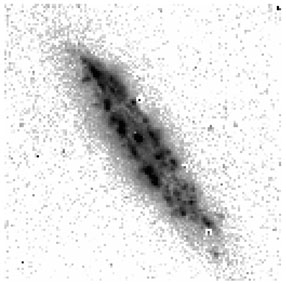 |
Figure 5. Extraplanar DIG layer in NGC3877
seen in this continuum subtracted
H |
 |
Figure 6. SN1998S (marked by a circle) in NGC3877. Our R-band image was obtained 354 days after the discovery of SN1998S. Image size and orientation is same as above. |
Another Virgo cluster spiral, NGC4216 has been classified as
a WR-galaxy, based on detected
HeII 4686
emission from a few regions within NGC4216
(Schaerer et al., 1999).
Pogge (1989b)
investigated
the morphology of the nuclear emission, and concluded it as diffuse, while
the circumnuclear region was characterized as faint and patchy. There is
nuclear emission detected from X-rays
(Fabbiano et al., 1992).
Maoz et al. (1996)
did not detect UV emission in NGC4216 in their HST survey. Our
H
4686
emission from a few regions within NGC4216
(Schaerer et al., 1999).
Pogge (1989b)
investigated
the morphology of the nuclear emission, and concluded it as diffuse, while
the circumnuclear region was characterized as faint and patchy. There is
nuclear emission detected from X-rays
(Fabbiano et al., 1992).
Maoz et al. (1996)
did not detect UV emission in NGC4216 in their HST survey. Our
H image did
not reveal extraplanar emission. The nucleus is the strongest source,
whereas several smaller HII regions in the outer spiral arm
contribute also to the
H
image did
not reveal extraplanar emission. The nucleus is the strongest source,
whereas several smaller HII regions in the outer spiral arm
contribute also to the
H emission.
emission.
NGC4235 has been classified as a Seyfert galaxy of type 1
(Weedman, 1978),
and has no physical companion
(Dahari, 1984).
Pogge (1989a) has
studied the nuclear environment using narrowband imaging of
H and
[OIII]. He found a bright nucleus with an extended region
towards the NE direction at P.A. ~ 48°, which extends ~ 4.4".
Neither disk HII regions were detected, nor ionized gas
above the plane. Radio continuum observations
(Hummel et al., 1991)
also did not find
evidence for extended emission. In the X-ray regime the strong nuclear
region is detected with a luminosity of
1.55 × 1042 erg s-1
(Fabbiano et al., 1992).
In a study of large-scale outflows in edge-on Seyfert galaxies
Colbert et al. (1996b)
found no double peaked line profiles, or any
evidence for extended line regions, and no minor axis emission,
too. However, on radio continuum images obtained with the VLA at 4.9 GHz
there was a
diffuse, bubble-like, extended structure (~ 9 kpc) found in addition
to the unresolved nucleus
(Colbert et al., 1996a).
Our H
and
[OIII]. He found a bright nucleus with an extended region
towards the NE direction at P.A. ~ 48°, which extends ~ 4.4".
Neither disk HII regions were detected, nor ionized gas
above the plane. Radio continuum observations
(Hummel et al., 1991)
also did not find
evidence for extended emission. In the X-ray regime the strong nuclear
region is detected with a luminosity of
1.55 × 1042 erg s-1
(Fabbiano et al., 1992).
In a study of large-scale outflows in edge-on Seyfert galaxies
Colbert et al. (1996b)
found no double peaked line profiles, or any
evidence for extended line regions, and no minor axis emission,
too. However, on radio continuum images obtained with the VLA at 4.9 GHz
there was a
diffuse, bubble-like, extended structure (~ 9 kpc) found in addition
to the unresolved nucleus
(Colbert et al., 1996a).
Our H image reveals a
bright nucleus with a faint extended layer, which is restricted to the
circumnuclear
part. NE of the nucleus a depression is visible, possibly due to absorbing
dust, as already noted by
Pogge (1989a),
and easily visible in the broad band HST image by
Malkan et al. (1998).
This is one of the very few Seyfert galaxies that
appear in our survey. The role of minor axis outflows in Seyfert galaxies,
and thus the contribution to the IGM enrichment and heating still has to be
explored.
image reveals a
bright nucleus with a faint extended layer, which is restricted to the
circumnuclear
part. NE of the nucleus a depression is visible, possibly due to absorbing
dust, as already noted by
Pogge (1989a),
and easily visible in the broad band HST image by
Malkan et al. (1998).
This is one of the very few Seyfert galaxies that
appear in our survey. The role of minor axis outflows in Seyfert galaxies,
and thus the contribution to the IGM enrichment and heating still has to be
explored.
NGC4388 has been identified as the first Seyfert2 galaxy in the Virgo cluster (Phillips & Malin, 1982), and has been studied extensively in various wavelength regimes, including optical line imaging and spectroscopy (e.g., Keel, 1983; Corbin et al., 1988; Pogge, 1988), radio continuum (e.g., Stone et al., 1988; Hummel & Saikia, 1991), and in the high energy waveband extended soft X-ray emission out to a radius of 4.5 kpc has been reported (Matt et al., 1994). From the optical morphology and kinematics it was derived that NGC4388 possesses complex gas kinematics and is composed of several nucleated emission line regions. A prominent feature reaches out to ~ 18" at P.A. ~ 10° (Heckman et al., 1983). The radio continuum maps revealed a double peaked radio source close to the optical nucleus plus a cloud of radio emitting material, apparently ejected from the nucleus (e.g., Stone et al., 1988; Irwin et al., 2000).
Some speculation on the true membership to the Virgo cluster exists, although
NGC4388 is located near the core of the Virgo cluster. This is because of
its relatively high systemic velocity. However, most authors assume it is a
member of the Virgo cluster. Therefore, ram pressure stripping
seems to
play a role as NGC4388 interacts with the ambient intracluster medium (ICM).
Optical narrowband imaging in
H and
[OIII] has
revealed that the morphology of the extended ionized gas is composed of two
opposed radiation cones
(Pogge, 1988),
which give rise to a hidden
Seyfert1 nucleus, as favored in the unification scheme of
AGN. Recent investigations of NGC4388 using Fabry-Perot imaging techniques
have revealed a complex of highly ionized gas ~ 4 kpc above the disk
(Veilleux et al., 1999).
They found blueshifted velocities of
50 - 250 km s-1 NE of the nucleus. Furthermore they assume
the velocity of
the extraplanar gas to be unaffected by the inferred supersonic motion of
NGC4388 through the ICM of the Virgo cluster, and suggest that the galaxy
and high-| z| gas lies behind the Mach cone.
and
[OIII] has
revealed that the morphology of the extended ionized gas is composed of two
opposed radiation cones
(Pogge, 1988),
which give rise to a hidden
Seyfert1 nucleus, as favored in the unification scheme of
AGN. Recent investigations of NGC4388 using Fabry-Perot imaging techniques
have revealed a complex of highly ionized gas ~ 4 kpc above the disk
(Veilleux et al., 1999).
They found blueshifted velocities of
50 - 250 km s-1 NE of the nucleus. Furthermore they assume
the velocity of
the extraplanar gas to be unaffected by the inferred supersonic motion of
NGC4388 through the ICM of the Virgo cluster, and suggest that the galaxy
and high-| z| gas lies behind the Mach cone.
Our narrowband imaging of NGC4388 (see Fig. 7)
reveals also extended
emission which is pointing away from the galactic disk to the halo in
the NE direction. Furthermore a faint eDIG layer is visible. Very
recently deep
H images obtained with
the Subaru telescope revealed very extended emission-line region in
H
images obtained with
the Subaru telescope revealed very extended emission-line region in
H and
[OIII] at distances of up to ~ 35 kpc
(Yoshida et al., 2002).
and
[OIII] at distances of up to ~ 35 kpc
(Yoshida et al., 2002).
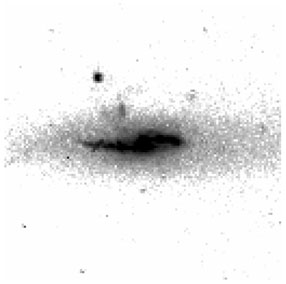 |
Figure 7. Continuum subtracted
H |
NGC4700 has been listed as a HII region galaxy in the list
of Rodriguez Espinosa et
al. (1987),
while Hewitt &
Burbidge (1991)
list it as a Seyfert2 galaxy. It
has been included in the HST imaging survey of nearby AGN
(Malkan et al., 1998).
NGC4700 has a relatively large ratio of
S60 / S100 of ~ 0.51,
making it a promising candidate with a potential DIG halo according to the
diagnostic DIG diagram. Indeed, a relatively bright, and extended gaseous
halo with a maximum extent of 2.0 kpc above/below the galactic plane is
discovered. One of the filaments can even be traced farther out to
~ 3 kpc. The morphology of DIG in NGC4700 is asymmetrical, with the
eastern and middle part being most prominent. Five distinct bright
HII region complexes, which are composed of several
individual
smaller regions across the disk, can be discerned. Some prominent filaments
above active regions protrude from the disk into the halo. A small
number of
bright HII regions is seen in this part of the disk, and the
maximum extent of the eDIG is visible above those regions. The western part
of the galaxy is lacking in bright HII regions, hence the
suppressed extend of the halo in this western part. NGC4700 also bears an
extended radio halo (radio thick disk), with the maximum extent
correspondingly on the same position above the disk
(Dahlem et al., 2001),
although slightly more extended in the radio continuum image as in our
H image (see Figs. 8 + 9).
image (see Figs. 8 + 9).
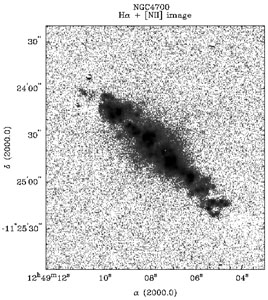 |
Figure 8. A detailed
H |
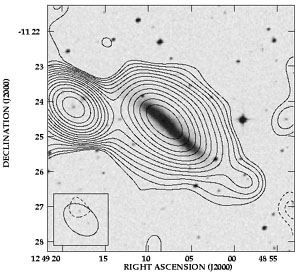 |
Figure 9. The extended radio halo of
NGC4700 at |
NGC4945 is a well studied southern edge-on spiral galaxy, which belongs to the Centaurus group. It has been studied at various wavelengths, including the visual, IR, and radio regime. Heckman et al. (1990) found evidence for a starburst driven superwind in NGC4945, and Moorwood & Olivia (1994) derive a ~ 400 pc size starburst in addition to the presence of a visually absorbed Seyfert nucleus. They conclude that NGC4945 is in an advanced stage of evolution from a starburst to a Seyfert galaxy. Extended emission from the disk was detected by radio continuum observations (Harnett et al., 1989; Colbert et al., 1996a), reaching a diameter of ~ 23 kpc. X-ray emission was detected from the nuclear region, however, no extended emission was found in ROSAT PSPC observations (Colbert et al., 1998), probably due to quite large absorbing columns (NH = 1.5 × 1021 cm-2), as NGC4945 is situated near the galactic plane (b ~ 13°). This decreases the sensitivity for the soft X-ray regime.
NGC4945 is one of the few starburst galaxies that we have included in our
H survey, and it is no
surprise that it has the second highest
LFIR / D225 ratio of ~
14.8 of our studied galaxies. Already investigated by
Lehnert & Heckman
(1995),
NGC4945 shows strong extraplanar DIG with
many filaments protruding from the disk into the halo. There are at least
two bright filaments on either side of the disk visible on our narrowband
images. Several prominent dust patches, which obscure some parts of the
emission south of the galactic plane is a further characteristic pattern
for this galaxy. In Fig. 10 we show an
enlargement of the middle part, which
nicely shows the outflow cone from the nuclear starburst.
survey, and it is no
surprise that it has the second highest
LFIR / D225 ratio of ~
14.8 of our studied galaxies. Already investigated by
Lehnert & Heckman
(1995),
NGC4945 shows strong extraplanar DIG with
many filaments protruding from the disk into the halo. There are at least
two bright filaments on either side of the disk visible on our narrowband
images. Several prominent dust patches, which obscure some parts of the
emission south of the galactic plane is a further characteristic pattern
for this galaxy. In Fig. 10 we show an
enlargement of the middle part, which
nicely shows the outflow cone from the nuclear starburst.
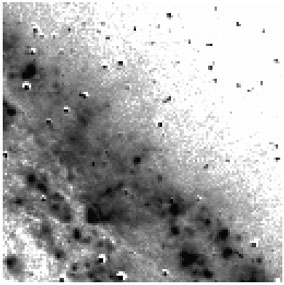 |
Figure 10. A zoom onto the outflowing cone
in this H |
This northern edge-on galaxy is part of the LGG361 group
(Garcia, 1993),
which teams up with NGC5289, which is located ~ 13' to the south, and
has a velocity difference to NGC5290 of ~ 67 km s-1
(Huchra et al., 1983).
In the optical NGC5290's most striking character is a box-shaped bulge
(de Souza & Dos
Anjos, 1987).
The LFIR / D225 ratio is
moderate (~ 2.6), and NGC5290 shows some extended emission, where a
faint layer is detected, and some filaments, basically coming from the
nuclear region and reaching into the halo, can be discerned (see
Fig. 11). The morphology that is visible on the
H image resembles those
of a starburst galaxy, although NGC5290 has no starburst-like FIR
parameters, as the S60 / S100 ratio
is considerably lower (0.31).
image resembles those
of a starburst galaxy, although NGC5290 has no starburst-like FIR
parameters, as the S60 / S100 ratio
is considerably lower (0.31).
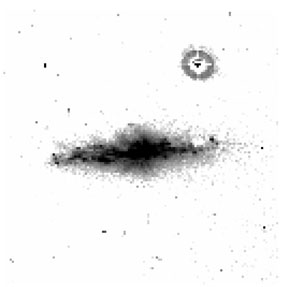 |
Figure 11. Continuum subtracted
H |
Another northern edge-on spiral, NGC5297 forms a binary galaxy with
NGC5296 (Turner, 1976),
which is separated by about 1.5' from NGC5297,
and has a velocity difference of
 v
v
 360 km s-1.
Another interesting source is also located in the direct vicinity, a quasar
of V = 19.3 mag
(Arp, 1976).
This quasar ([HB89]1342+440), which has a
redshift of z = 0.963, is located 2.5' to the SW. Arp reports on
a luminous extension from NGC5236 pointing at the QSO, which
Sharp (1990) did not
confirm. However,
Sharp (1990)
did comment on the unusually bright
off-center secondary nucleus of NGC5296. The QSO is marked by a circle in
our R-band image in Fig. 40. The outer spiral arms of NGC5297 show
evidence of perturbation by the S0 companion, as reported by
(Rampazzo et al., 1995).
360 km s-1.
Another interesting source is also located in the direct vicinity, a quasar
of V = 19.3 mag
(Arp, 1976).
This quasar ([HB89]1342+440), which has a
redshift of z = 0.963, is located 2.5' to the SW. Arp reports on
a luminous extension from NGC5236 pointing at the QSO, which
Sharp (1990) did not
confirm. However,
Sharp (1990)
did comment on the unusually bright
off-center secondary nucleus of NGC5296. The QSO is marked by a circle in
our R-band image in Fig. 40. The outer spiral arms of NGC5297 show
evidence of perturbation by the S0 companion, as reported by
(Rampazzo et al., 1995).
Radio continuum observations of NGC5297 have been performed
(Irwin et al., 2000; Hummel et al., 1985; Irwin et al., 1999). While
Irwin et al. (1999)
claims extended radio continuum
emission from NGC5297, still, higher resolution observations show only
very weak emission
(Irwin et al., 2000).
Our H image does not
reveal any
extraplanar emission. Thus, we do not see enhanced SF activity due to the
interaction with the companion galaxy in this case. The
LFIR / D225 ratio is
moderate. We also note, that this galaxy actually is not
perfectly edge-on.
image does not
reveal any
extraplanar emission. Thus, we do not see enhanced SF activity due to the
interaction with the companion galaxy in this case. The
LFIR / D225 ratio is
moderate. We also note, that this galaxy actually is not
perfectly edge-on.
From HI observations it was found that NGC5775 is an
interacting galaxy with its neighbor face-on spiral NGC5774. Emission
along a bridge has been detected, although no tidal arms are discovered
(Irwin, 1994).
NGC5775 is a good studied northern edge-on galaxy in the
disk-halo context, which has been imaged in
H (Tüllmann et al.,
2000;
Collins et al., 2000;
Lehnert & Heckman,
1995),
where extraplanar emission was detected out to
over 5 kpc above the galactic plane. It is the galaxy with the highest
LFIR / D225 ratio in our
sample and is a starburst-type galaxy,
although no clear indications exist on a nuclear starburst. A bright halo
with individual filaments superposed in a prominent X-shape are
discovered on our narrowband image, consistent with earlier observations,
mentioned above. Extraplanar DIG has been detected spectroscopically out to
9 kpc
(Tüllmann et al.,
2000;
Rand, 2000),
and extended radio continuum emission has been detected as well
(Duric et al., 1998;
Hummel et al., 1991).
Extended X-ray emission coexistent
with a radio continuum spur and optical filament was discovered on ROSAT
PSPC archival images
(Rossa, 2001).
(Tüllmann et al.,
2000;
Collins et al., 2000;
Lehnert & Heckman,
1995),
where extraplanar emission was detected out to
over 5 kpc above the galactic plane. It is the galaxy with the highest
LFIR / D225 ratio in our
sample and is a starburst-type galaxy,
although no clear indications exist on a nuclear starburst. A bright halo
with individual filaments superposed in a prominent X-shape are
discovered on our narrowband image, consistent with earlier observations,
mentioned above. Extraplanar DIG has been detected spectroscopically out to
9 kpc
(Tüllmann et al.,
2000;
Rand, 2000),
and extended radio continuum emission has been detected as well
(Duric et al., 1998;
Hummel et al., 1991).
Extended X-ray emission coexistent
with a radio continuum spur and optical filament was discovered on ROSAT
PSPC archival images
(Rossa, 2001).
ESO274-1 belongs to the Cen A group of galaxies, and
Banks et al. (1999)
derive a HI mass of 430 × 106
M , ranking
on position five of the Cen A group. This little studied southern
edge-on galaxy was included in the recent list of dwarf galaxies by
Cote et al. (1997),
who studied new discovered dwarf galaxies in the nearest
groups of galaxies. From optical inspection of the DSS images, it is
obvious
that this galaxy has a low surface brightness. It is the galaxy with the
lowest LFIR / D225 ratio
among the IRAS detected galaxies in our sample (0.19)! Quite remarkably
however, the
S60 / S100 ratio is among
the highest in our sample, making ESO274-1 a promising candidate in search
for eDIG. We show in Fig. 12 an enlargement of
the most active SF regions,
which show strong local extended emission. The SW and middle part is most
prominent, whereas there are regions in the NE part, where this galaxy
(superposed by a crowded field of foreground stars) is almost invisible in
H
, ranking
on position five of the Cen A group. This little studied southern
edge-on galaxy was included in the recent list of dwarf galaxies by
Cote et al. (1997),
who studied new discovered dwarf galaxies in the nearest
groups of galaxies. From optical inspection of the DSS images, it is
obvious
that this galaxy has a low surface brightness. It is the galaxy with the
lowest LFIR / D225 ratio
among the IRAS detected galaxies in our sample (0.19)! Quite remarkably
however, the
S60 / S100 ratio is among
the highest in our sample, making ESO274-1 a promising candidate in search
for eDIG. We show in Fig. 12 an enlargement of
the most active SF regions,
which show strong local extended emission. The SW and middle part is most
prominent, whereas there are regions in the NE part, where this galaxy
(superposed by a crowded field of foreground stars) is almost invisible in
H .
.
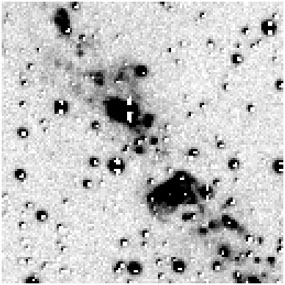 |
Figure 12. Prominent extraplanar emission
regions in this continuum subtracted
H |
This is a perfect edge-on galaxy, and it is the only one of type S0-a in
our sample. It was only included because of its classification as type
Sa in the NED. It shows a strong dust lane, and a strikingly bright, and
extended bulge in the R-band image. An upper radio continuum flux limit of
20 mJy at  11cm has been
given by
Sadler (1984),
and a upper flux limit of F[N II] < 1.6 ×
10-14 erg s-1 cm-2 has been derived by
Phillips et al. (1986).
We detect
no extended emission in ESO142-19. Even the disk is almost invisible on
our H
11cm has been
given by
Sadler (1984),
and a upper flux limit of F[N II] < 1.6 ×
10-14 erg s-1 cm-2 has been derived by
Phillips et al. (1986).
We detect
no extended emission in ESO142-19. Even the disk is almost invisible on
our H image.
image.
IC5052 is a late-type spiral with classifications Scd or Sd. Radio
emission detected by
 35cm observations
revealed an unusually
double peaked radio emission complex associated with the disk, which was
not coming from the nucleus
(Harnett & Reynolds,
1991).
35cm observations
revealed an unusually
double peaked radio emission complex associated with the disk, which was
not coming from the nucleus
(Harnett & Reynolds,
1991).
Our H image reveals a
bright layer of extraplanar DIG superposed by
individual filaments and shells (see Fig. 13).
There is a depression in the
H
image reveals a
bright layer of extraplanar DIG superposed by
individual filaments and shells (see Fig. 13).
There is a depression in the
H distribution noticed
in the southern part of the galaxy, due to
significant dust absorption, which almost separates the galaxy in two
parts. An asymmetrical distribution is also visible in the R-band
image. The southern edge is dominated by
H
distribution noticed
in the southern part of the galaxy, due to
significant dust absorption, which almost separates the galaxy in two
parts. An asymmetrical distribution is also visible in the R-band
image. The southern edge is dominated by
H emission, whereas the
broadband
image shows almost no intensity. Several arcs and shells make this galaxy a
good target for further high resolution studies.
emission, whereas the
broadband
image shows almost no intensity. Several arcs and shells make this galaxy a
good target for further high resolution studies.
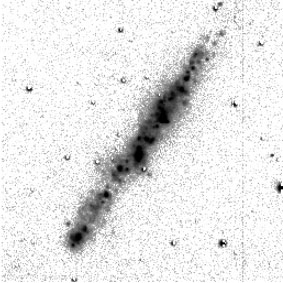 |
Figure 13. Continuum subtracted
H |
Pa observations with
NICMOS 2 HST
(Böker et al.,
1999)
showed excess
emission of an isolated region in the disk-halo interface, slightly offset
from the disk, which is possibly associated with one of the brighter
emission regions in the southern part of our
H
observations with
NICMOS 2 HST
(Böker et al.,
1999)
showed excess
emission of an isolated region in the disk-halo interface, slightly offset
from the disk, which is possibly associated with one of the brighter
emission regions in the southern part of our
H image. The diagnostic
ratios are both moderate, so it is quite remarkable that extended DIG
emission is detected in that abundance in IC5052.
image. The diagnostic
ratios are both moderate, so it is quite remarkable that extended DIG
emission is detected in that abundance in IC5052.
NGC7064 is a HII region like galaxy
(Kirhakos & Steiner,
1990). Radio
emission has been detected at
 35 cm
(Harnett & Reynolds,
1991),
which extends
over the inner disk with a maximum intensity at the nucleus. The disk
emission is more pronounced to the east, which corresponds to the optical
emission distribution. They further show in their map a weak extension to
the south, which apparently has no optical counterpart. NGC7064 has also
been detected in the ROSAT All Sky Survey (RASS), which was included in a
study of IRAS galaxies
(Boller et al., 1998).
The X-ray intensity maximum is
offset from the IRAS position (nucleus). Furthermore, weaker emission is
detected to the south of NGC7064 at larger distances far out in the halo
region. Presently it is not clear if it is related to NGC7064. In
Fig. 14
we show our H
35 cm
(Harnett & Reynolds,
1991),
which extends
over the inner disk with a maximum intensity at the nucleus. The disk
emission is more pronounced to the east, which corresponds to the optical
emission distribution. They further show in their map a weak extension to
the south, which apparently has no optical counterpart. NGC7064 has also
been detected in the ROSAT All Sky Survey (RASS), which was included in a
study of IRAS galaxies
(Boller et al., 1998).
The X-ray intensity maximum is
offset from the IRAS position (nucleus). Furthermore, weaker emission is
detected to the south of NGC7064 at larger distances far out in the halo
region. Presently it is not clear if it is related to NGC7064. In
Fig. 14
we show our H image,
scaled logarithmically, to show the faint halo.
A few emission patches and plumes are visible to the south of the disk, and
also in the northern part. The disk emission is asymmetrically distributed,
with the eastern part being most prominent. There is a prominent hole in
the southern disk, bisecting the disk almost entirely. In our
logarithmically scaled image the hole is almost filled with diffuse
emission, but its intensity is weaker than in the eastern and western
part of the disk-halo interface. Although the
LFIR / D225 ratio is
quite low, it should be noted that the
S60 / S100 ratio is the highest in
our sample.
image,
scaled logarithmically, to show the faint halo.
A few emission patches and plumes are visible to the south of the disk, and
also in the northern part. The disk emission is asymmetrically distributed,
with the eastern part being most prominent. There is a prominent hole in
the southern disk, bisecting the disk almost entirely. In our
logarithmically scaled image the hole is almost filled with diffuse
emission, but its intensity is weaker than in the eastern and western
part of the disk-halo interface. Although the
LFIR / D225 ratio is
quite low, it should be noted that the
S60 / S100 ratio is the highest in
our sample.
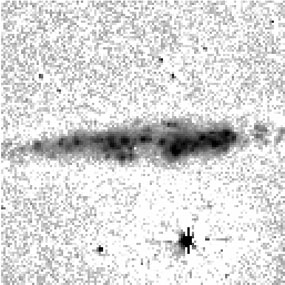 |
Figure 14. Continuum subtracted
H |
This southern edge-on spiral has radio continuum detections at
 35cm (Harnett &
Reynolds, 1985).
The radio emission follows the plane of the galaxy,
and extends above it in two distinct spurs out to a distance of
~ 1.5 kpc. The radio peak coincide with the optical nucleus, however,
they note no obvious nuclear radio source. Our R-band image shows that a
prominent dust lane with patchy structures runs across most parts of
the disk offset slightly to the north. It is very irregular, unlike most
other prominent dust lanes, such as in NGC891 or IC2531. The
H
35cm (Harnett &
Reynolds, 1985).
The radio emission follows the plane of the galaxy,
and extends above it in two distinct spurs out to a distance of
~ 1.5 kpc. The radio peak coincide with the optical nucleus, however,
they note no obvious nuclear radio source. Our R-band image shows that a
prominent dust lane with patchy structures runs across most parts of
the disk offset slightly to the north. It is very irregular, unlike most
other prominent dust lanes, such as in NGC891 or IC2531. The
H image (Fig. 15) reveals a faint halo, in
addition to some filaments and
extended emission in the form of knots. The northeastern part of the galaxy
has the highest intensity in emission, whereas the southern half is almost
absent, except very few emission patches (HII regions) in
the disk. The filaments protrude basically from the nuclear region into the
halo. It should be noted that the extended radio continuum emission is
coincident with the
H
image (Fig. 15) reveals a faint halo, in
addition to some filaments and
extended emission in the form of knots. The northeastern part of the galaxy
has the highest intensity in emission, whereas the southern half is almost
absent, except very few emission patches (HII regions) in
the disk. The filaments protrude basically from the nuclear region into the
halo. It should be noted that the extended radio continuum emission is
coincident with the
H extended emission.
extended emission.
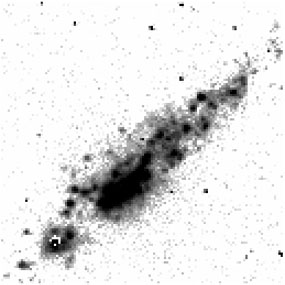 |
Figure 15. Continuum subtracted
H |
NGC7184 was detected in the radio regime at
 20cm continuum
emission (Condon, 1987),
and bears a double peaked brightness distribution. This was confirmed by
Harnett & Reynolds
(1991),
who detected two maxima at
20cm continuum
emission (Condon, 1987),
and bears a double peaked brightness distribution. This was confirmed by
Harnett & Reynolds
(1991),
who detected two maxima at
 35cm. NGC7184 is
located at a projected distance of 163 kpc
(20.9') to NGC7185, as quoted by
Kollatschny & Fricke
(1989),
who studied the group
environment of Seyfert galaxies. A peculiar supernova was detected in
NGC7184, named SN1984N
(Barbon et al., 1999).
Our H
35cm. NGC7184 is
located at a projected distance of 163 kpc
(20.9') to NGC7185, as quoted by
Kollatschny & Fricke
(1989),
who studied the group
environment of Seyfert galaxies. A peculiar supernova was detected in
NGC7184, named SN1984N
(Barbon et al., 1999).
Our H image did not
show any extraplanar emission, which might be due to the fact, that
NGC7184 is not perfectly edge-on. The outstanding feature in NGC7184 is
the inner ring, which is also prominently seen on the R-band image. There
is a well pronounced sub-structure visible, and several HII
regions can be discerned in the ring and in the outer spiral arms.
image did not
show any extraplanar emission, which might be due to the fact, that
NGC7184 is not perfectly edge-on. The outstanding feature in NGC7184 is
the inner ring, which is also prominently seen on the R-band image. There
is a well pronounced sub-structure visible, and several HII
regions can be discerned in the ring and in the outer spiral arms.
The late type spiral NGC7339 is accompanied by the galaxy NGC7332 at a
projected distance of 5.2', the latter one being a peculiar S0 galaxy,
which has a velocity difference of
 v = - 141 km
s-1 in
comparison to NGC7339. A supernova (SN1989L) has been discovered in
NGC7339
(Barbon et al., 1999).
Several bright, and compact knots are
seen in our H
v = - 141 km
s-1 in
comparison to NGC7339. A supernova (SN1989L) has been discovered in
NGC7339
(Barbon et al., 1999).
Several bright, and compact knots are
seen in our H image, but
no extraplanar emission is detected.
NGC7332, which is also visible on our frame, is
completely absent in H
image, but
no extraplanar emission is detected.
NGC7332, which is also visible on our frame, is
completely absent in H .
.
UGC12281 has already been studied in the DIG context a few years ago by Pildis et al. (1994). They claim to have detected two extraplanar emission line features (discrete clouds), and a clumpy plume. We can confirm the presence of these two clouds, and the plume is also marginally detected in our image, which suffers from low S/N.
This southern edge-on spiral was detected with the VLA at
 = 1.49 GHz
(Condon et al.,
1987), and
Maoz et al. (1996)
have conducted UV observations at
(
= 1.49 GHz
(Condon et al.,
1987), and
Maoz et al. (1996)
have conducted UV observations at
( 2300Å)
of the inner 22" × 22" region with the HST,
where they detected a star-forming morphology in several distinct
regions (knots). Our
H
2300Å)
of the inner 22" × 22" region with the HST,
where they detected a star-forming morphology in several distinct
regions (knots). Our
H image
(Fig. 16) reveals an extended DIG layer
with individual plumes and faint filaments superposed. The disk emission is
composed of several distinct emission complexes, clustered basically in
three regions (nucleus + two regions within the disk), and some fainter
regions in the outskirts of the disk.
image
(Fig. 16) reveals an extended DIG layer
with individual plumes and faint filaments superposed. The disk emission is
composed of several distinct emission complexes, clustered basically in
three regions (nucleus + two regions within the disk), and some fainter
regions in the outskirts of the disk.
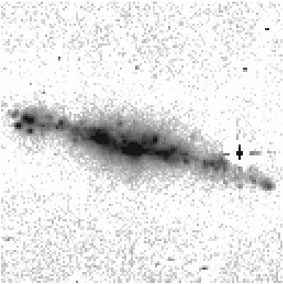 |
Figure 16. Continuum subtracted
H |
UGC12423 belongs to the Pegasus I cluster of galaxies, and was once
reported being one of the most massive and luminous spirals, with a derived
HI mass of ~ 9 × 109
M , and
logMH / LB = + 0.14
(Schommer & Bothun,
1983;
Bothun et al., 1982).
Hummel et al. (1991)
did not detect
extended emission from UGC12423 in their radio continuum survey.
Our H
, and
logMH / LB = + 0.14
(Schommer & Bothun,
1983;
Bothun et al., 1982).
Hummel et al. (1991)
did not detect
extended emission from UGC12423 in their radio continuum survey.
Our H image also does
not show any extraplanar emission. The galaxy
is almost invisible in H
image also does
not show any extraplanar emission. The galaxy
is almost invisible in H .
This can partly be attributed to
insufficient S/N, as we unfortunately only acquired one exposure for
H
.
This can partly be attributed to
insufficient S/N, as we unfortunately only acquired one exposure for
H , and also the R-band
image was not long enough integrated. This
needs to be re-investigated with more sensitive observations.
, and also the R-band
image was not long enough integrated. This
needs to be re-investigated with more sensitive observations.
4 http://www.roe.ac.uk/wfau/halpha/halpha.html Back.